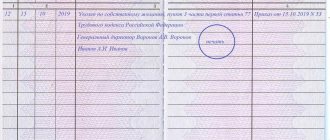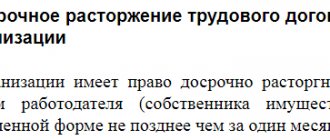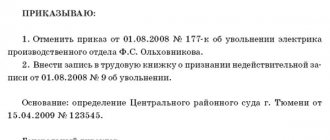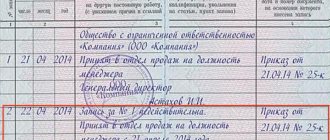Despite the abundance of explanations, making a correct entry about dismissal in the work book and electronic register with relevant information (SZV-TD) is not always easy. Difficulties arise with correctly determining the basis for dismissal, selecting the appropriate article of the Labor Code of the Russian Federation, and making a decision on more detailed disclosure in the record of the reason for the employee’s departure. But most difficulties can be solved with a comprehensive consideration of legal norms and strict adherence to instructions. We analyze how to make notes on dismissal and provide samples of them for 2021.
Also see:
- Rules for filling out work books in 2021
- Correction of the dismissal date in the work book: sample
Basic rules for recording a dismissal
Entries in the work book about the termination of the employment contract are made in strict accordance with labor legislation. The general rules for their conduct are fixed in two fundamental regulatory guidelines:
- In the Rules for maintaining and storing work books (Government Decree No. 225 of April 16, 2003).
- In the Instructions for filling out work books (Resolution of the Ministry of Labor and Social Development No. 69 of October 10, 2003).
The reference to the reason for dismissal is of fundamental importance in the record. When indicating such a basis, no deviations from the letter of the law are allowed. Records must be compiled in strict accordance with the statement of grounds for dismissal contained in Art. 84.1 Labor Code of the Russian Federation.
The entry is made on the day of the change in the employee’s work activity. This regulation applies even more so to such a fundamentally important record for any worker as the recording of dismissal. The registration must be completed on the same day with the signature of the dismissal order. The only exception to this rule is the termination of an employment contract due to the death of an employee, when it is necessary to wait for the receipt of a death certificate.
Work books are strict reporting forms. Based on this fact, business guidelines have been drawn up that require strict adherence to the procedure for filling them out, recording and storing them. They are set out in the sixth section of the Rules, which requires the maintenance of two journals for their accounting:
- A receipt and expenditure book, which records information on the acquisition and consumption of work books.
- Book of movement of labor records, in which all data about the worker is entered: F.I. O., position held according to the staffing table, rank, category, time of hiring, stages of promotion, available penalties, awards, time and reasons for dismissal.
In a large company, the HR department is in charge of processing and storing work books. But if a small organization or individual entrepreneur does not have such a service, then its function is performed by the responsible persons appointed by order for the enterprise or the individual entrepreneur himself (clause 45 of the Rules).
conclusions
Every employee working on an official basis must have a work book. The document displays all information regarding employment. Chief among these is hiring and firing.
When terminating the contract, the relevant information is entered into the specified document - the reason for dismissal, a link to the regulatory act on the basis of which this process is carried out. In the case of electronic labor, upon termination of a business relationship, the employee receives a completed unified STD-R form.
Features of recording records depending on the reason for dismissal
The main difficulty when recording a dismissal is recording its reason. In real life, there can be a lot of reasons for dismissal, from “they don’t get along” to “moving to another area.” The Labor Code contains a list on this subject with strictly defined wording set out in Art. 84.
Here are thirteen main reasons for dismissal:
- By agreement of the parties.
- Due to the expiration of the contract.
- At the request of the worker himself.
- At the initiative of the employer.
- Due to transfer to another job.
- When electing a team member to an elective position.
- When an employee does not want to continue the employment relationship due to undesirable changes in working conditions or a change in the owner of the company.
- Due to the employee’s reluctance to remain in an enterprise that has undergone reorganization with different conditions of labor relations, or when changing subordination.
- Due to health conditions, when it becomes physically impossible for a member of the workforce to work in the same place, and the company does not have a position with easier conditions.
- When an employee himself does not want to move to the position offered to him at the enterprise, which is accessible to him based on his physical characteristics.
- Due to a change in the location of the company and the employee’s refusal to move to another region.
- Due to the inability to continue the employment relationship for reasons beyond the control of both parties (conscription for military service, conviction by court, death, etc.). Almost all of these situations are described in Art. 83 Labor Code of the Russian Federation.
- Due to identified violations of a previously concluded agreement that can no longer be corrected.
As you can see, there are many reasons for dismissal. But there are even more formulations that need to be stated in strict accordance with the provisions of the Labor Code and indicating the specific clause of the article of the Labor Code of the Russian Federation, which is the basis for dismissal.
The following describes the compilation of standard records for the most common cases of dismissal.
Dismissal at your own request
This basis is used most often, as it is the most convenient for the employer in material and legal aspects.
There are two options for recording here:
- “Dismissed at his own request”;
- “The employment contract was terminated at the initiative of the employee.”
The first option follows the requirements of paragraph 5.2 of Instruction of the Ministry of Labor No. 69, and the second corresponds to the provisions of Art. 84.1 Labor Code of the Russian Federation. Both recording methods are quite correct and legally identical. After writing the grounds for dismissal, a link to paragraph 3 of Art. 77 Labor Code of the Russian Federation.
Currently, the legislator requires that the dismissal record be certified by the employee himself. To certify that he has read the record, he must simply sign below the signature of the HR employee or first write the word “acquainted” and sign. These options are constantly discussed by specialists who cannot come to a single solution.
The basis for voluntary dismissal is clause 3, part 1, art. 77 Labor Code of the Russian Federation
When resigning at their own request, employees often receive benefits established by law. The most common conditions for receiving such additional payments are:
- dismissal to care for a child under 14 years of age;
- dismissal when one of the spouses moves to work in a region far from the enterprise.
If special circumstances arise, in addition to the main record, this reason for dismissal is indicated (clause 5.6 of the Instructions of the Ministry of Labor).
Dismissal at the initiative of the employer
There are five grounds on which a worker is dismissed at the initiative of the employer (Article 81 of the Labor Code of the Russian Federation):
- Termination of the company's activities.
- The emergence of a new owner of the company.
- Team reduction.
- Gross violations of discipline and labor protection.
- Systematic neglect of conscientious performance of one's work duties.
Although the list of reasons for parting with an employee does not end there. Here you can also write “dismissed” or “employment contract terminated” in the third column of the book. Both options are correct and can be applied on the same legal basis.
Dismissal due to staff reduction is one of the most common cases of dismissal at the initiative of the employer.
Table: the most common formulations used for dismissal at the initiative of the employer
| Article | Entry in column 3 |
| Clause 1 Part 1 Art. 81 Labor Code of the Russian Federation | Dismissed due to termination of activities by an individual entrepreneur, paragraph 1 of part 1 of Article 81 of the Labor Code of the Russian Federation. |
| clause 2 part 1 | Dismissed due to a reduction in the organization's workforce, clause 2 of part 1 of article 81 of the Labor Code of the Russian Federation. |
| clause 2 part 1 | Dismissed due to a reduction in the number of employees of the organization, clause 2 of part 1 of article 81 of the Labor Code of the Russian Federation |
| clause 2 part 1 | Dismissed due to a reduction in the number of employees of an individual entrepreneur, paragraph 2 of part 1 of Article 81 of the Labor Code of the Russian Federation |
| clause 2 part 1 | Dismissed due to a reduction in the number of employees of an individual entrepreneur, paragraph 2 of part 1 of Article 81 of the Labor Code of the Russian Federation |
| clause 3 part 1 | Dismissed due to inadequacy of the position held due to insufficient qualifications confirmed by certification results, clause 3 of part 1 of article 81 of the Labor Code of the Russian Federation |
| clause 3 part 1 | Dismissed due to inadequacy of the work performed due to insufficient qualifications, confirmed by certification results, clause 3 of part 1 of article 81 of the Labor Code of the Russian Federation |
| clause 4 part 1 | Dismissed due to a change in the owner of the property, clause 4, part 1, article 81 of the Labor Code of the Russian Federation |
| clause 5 part 1 | Dismissed for repeated failure to fulfill job duties without good reason, clause 5, part 1, article 81 of the Labor Code of the Russian Federation |
| Subp. “a” clause 6, part 1, article 81 of the Labor Code of the Russian Federation | Dismissed for absenteeism, subparagraph “a” of paragraph 6 of part 81 of the Labor Code of the Russian Federation or Dismissed for a single gross violation of labor duties - absenteeism, subparagraph “a” of paragraph 6 of part 81 of the Labor Code of the Russian Federation |
| Subp. “b” clause 6, part 1, article 81 of the Labor Code of the Russian Federation | Dismissed for appearing at work while intoxicated, subparagraph “b” of paragraph 6 of part 1 of article 81 of the Labor Code of the Russian Federation |
| Subp. “b” clause 6, part 1, article 81 of the Labor Code of the Russian Federation | Dismissed for appearing at work in a state of drug intoxication, subparagraph “b” of paragraph 6 of part 1 of article 81 of the Labor Code of the Russian Federation |
| Subp. “c” clause 6, part 1, article 81 of the Labor Code of the Russian Federation | Dismissed for disclosing a legally protected secret (commercial), subparagraph “c” of paragraph 6 of part 1 of Article 81 of the Labor Code of the Russian Federation |
| Subp. “c” clause 6, part 1, article 81 of the Labor Code of the Russian Federation | Dismissed for disclosing personal data of another employee, subparagraph “c” of paragraph 6 of part 1 of article 81 of the Labor Code of the Russian Federation |
| Subp. “d” clause 6, part 1, article 81 of the Labor Code of the Russian Federation | Dismissed for committing theft of someone else's property at the place of work, established by a court verdict that has entered into legal force, subparagraph “d” of paragraph 6 of part 1 of Article 81 of the Labor Code of the Russian Federation |
| Subp. “d” clause 6, part 1, article 81 of the Labor Code of the Russian Federation | Dismissed for violation of labor safety requirements established by the labor safety commission, which resulted in grave consequences (industrial accident), subparagraph “d” of paragraph 6 of part 1 of Article 81 of the Labor Code of the Russian Federation. |
| clause 7.1 part 1 | Dismissed for committing guilty actions giving grounds for loss of trust on the part of the employer, clause 7 of part 1 of article 81 of the Labor Code of the Russian Federation |
| clause 8.1 part 1 | Dismissed for committing an immoral offense incompatible with the continuation of this work, clause 8 of part 1 of article 81 of the Labor Code of the Russian Federation |
| clause 9.1 part 1 | Dismissed for making an unreasonable decision that resulted in a violation of the safety of property, clause 9 of part 1 of article 81 of the Labor Code of the Russian Federation |
| clause 10 part 1 | Dismissed for a single gross violation of labor duties, clause 10 of part 1 of article 81 of the Labor Code of the Russian Federation |
| clause 11 part 1 | Dismissed for providing false documents to the employer when concluding an employment contract, clause 11 of part 1 of article 81 of the Labor Code of the Russian Federation |
Dismissal due to health reasons
Dismissal due to deteriorating health is possible both at the request of the worker himself and at the initiative of the employer. The entry for dismissal caused at the request of the employee himself, in this case, is identical to the entry for dismissal at his own request.
True, there is one significant nuance here - if the manager is interested in the employee staying, he has the right to demand that he write about the reasons for his decision and ask him to document his level of health. Then, upon receipt of a medical report confirming the impossibility of further work, it is easier and more cost-effective for the enterprise to register the entry as voluntary dismissal.
But in case of dismissal at the initiative of the employer, depending on the specific situation, various ways of recording are possible. In any case, the employer is first obliged to offer the employee a position that he can handle based on his physical condition. The employee must refuse the offered position in writing, and after that, on the basis of his disagreement with the employer’s position, he can be dismissed.
The record of dismissal for health reasons must indicate that the employee refused the position offered to him that was suitable for his level of health.
The entry will look like this:
The employment contract was terminated due to the employee’s refusal to transfer to another job, which he needed in connection with a medical report, clause 8 of part 1 of article 77 of the Labor Code of the Russian Federation.
But when the employer does not have a position that the employee could handle based on his physical capabilities, then the following entry is left in the work record:
The employment contract was terminated due to the employer’s lack of work required by the employee in accordance with the medical report, paragraph 8 of part 1 of article 77 of the Labor Code of the Russian Federation.
Dismissal due to transfer
The law provides two ways for transferring to another company (clause 5, article 77 of the Labor Code of the Russian Federation):
- at the request of the employee;
- at the initiative of the employer, but with the consent of the employee.
Depending on the variations of this basis, a suitable entry is made (clause 6.1 of the Instructions of the Ministry of Labor). Please note that when applying for a job at the company specified upon dismissal, it is also necessary to emphasize that we are talking about employment by transfer. However, the clarification that the transfer is carried out at the request of the employee or with his consent is not displayed in the record.
Dismissal due to transfer can be either at the request of the employee or at the initiative of the employer
Dismissal of an employee working under a temporary employment agreement
Hiring is formalized in a standard way, but upon dismissal, the entry in the work book is somewhat different. Here it looks like this:
Dismiss due to the expiration of the employment contract, clause 2 of part 1 of article 77 of the Labor contract of the Russian Federation.
Dismissal due to death
Death is recorded solely on the basis of legal documents: a death certificate or a court order declaring the missing person dead.
The order and record of dismissal here are not drawn up immediately, but on the basis of the received evidence or decision. The word “dismiss” cannot be used in the order or record, since only a living person can be fired. Instead you need to write:
Termination of an employment contract due to the death of an employee, clause 6, part 1 of article 83 of the Labor Code of the Russian Federation.
In this case, in the work book it is necessary to write about termination of the employment contract, and not about dismissal
The work book is issued to one of the close relatives of the deceased or sent by registered mail. For personal issuance, a receipt is required from the recipient.
Certification of entries in the work book
The dismissal record is certified by two signatures and a seal. According to clause 10 of the Rules, records of dismissal are signed:
- the employer or employee responsible for maintaining work records;
- dismissed employee.
Usually, when the employer is an individual entrepreneur, he himself certifies the record, since most often there is no special employee for this on the individual entrepreneur’s staff.
In a situation where an employee resigns from a more or less large company, the record theoretically has the right to be signed by its manager. In practice, the company issues an order that appoints someone responsible for maintaining work records. He signs the entry in the work book on full legal grounds. If such a situation arises that at the moment of dismissal such a responsible person is on vacation or on sick leave, then two options are possible:
- the entry is signed by the temporary performer appointed by the order;
- The signature is made by the head of the enterprise himself.
The signature is drawn up in accordance with GOST 6.30 (Unified system of organizational and administrative documents). It includes:
- job title of the signatory;
- the painting itself;
- FULL NAME.
At the same time, the position and full name The statements of the signatory must be written out in full without any abbreviations. For example, you cannot write “Individual Entrepreneur” instead of “individual entrepreneur”.
Below the signature of the responsible person is the signature of the dismissed employee. It is done in the same way as the previous signature, according to all the rules. It cannot be just an incomprehensible stroke of the pen.
And it is also not allowed for the employee’s signature to stand next to the signature of the responsible person. It should only fit below.
Before the employee’s signature, the entry “read” or “read the records” is placed in his own hand.
Signatures are certified by a seal. Previously, an entry in a work book could be certified with the seal of the organization or the seal of the personnel department. However, according to paragraph 35 of the order of Rostrud, since 2008, signatures can only be certified with the seal of the enterprise.
When establishing a seal impression, the following rules must be observed:
- the seal should not cover signatures and other lines, preventing them from being read;
- the imprint should lightly touch the record of the position of the dismissed employee;
- The print must be unsmeared and readable.
Example of filling out a work book: information about the employee
So, the “starting” information about the employee is entered into the work book by his first employer. What kind of information is this? This is the surname, first name, patronymic, date of birth, education of the employee at the time of establishment of the work record book. All this information must be entered in the appropriate columns of the title page.
For tax consequences for the employer when issuing a work book, see the material “The Ministry of Finance reminded how to deal with VAT and profit when issuing work books.”
NOTE! The organization fills out such fields based on the original supporting documents provided by the employee (passport or other identification document, education diploma, etc.). But if for some reason the employee cannot provide the originals, then the company has the right to fill out the title page of the work book based on copies, which must be notarized.
After all the specified information about the employee has been entered into the work book, it is necessary to complete the filling procedure. To do this, the company puts the date of completion on the title page and personally demonstrates to the employee the information that was entered in the book. Next, the employee, if all the information entered is correct, must put his signature on the title page, after which a representative of the personnel department signs on the same sheet. At this point, information about the employee is considered entered.
Once completed, the work book remains in the HR department of the employing company.
However, if any “starting” information about the employee has changed (for example, the last name or first name has changed), then the company must update the information in the work book. To do this, you should cross out the old data and enter new ones (if the changes concern the name, surname or patronymic of the specialist). If the changes concern education/profession, then you should simply add the current information to the work book as an additional entry immediately after the previous data (clauses 2.3–2.4 of Instruction No. 69).
Correcting and replacing entries
There are legally established rules governing changes to entries in work books.
Corrections to employee information
Changes in the name of the owner of the work book are made on the basis of information from documents proving his identity. They are placed on the title page by crossing out old lines and writing new entries next to the crossed out data. Previous data is crossed out with a thin solid line to make it readable. A record of the name of the document on the basis of which the personal data was changed is placed on the inner, empty cover page. The details of the document must be recorded. This entry is accompanied by the signature of the responsible employee or the signature of the employer. It is certified by the company seal. It is prohibited to affix the seal of the HR department.
When information about an employee changes, the old entry is neatly crossed out with one line, and the basis for the change is written on the back.
It should be especially emphasized that everything written on the title page can only be changed and is strictly prohibited from being corrected. A book with an incorrectly filled out title page must be changed as invalid and a new one must be registered . The cost of its acquisition must be reimbursed by the employer himself, and the damaged copy must be destroyed.
Changes in employment information
All incorrect information may be corrected if certain conditions are met. These corrections are made at the company whose personnel officers made a mistake when filling out the entry, or at another production facility on the basis of documents sent from the first job. If the previous enterprise was reorganized, then its legal successor must provide the document. And if the old company is closed or the individual entrepreneur has closed his business, then the corrections are made by the new employer.
Unlike changes on the title page, entries about changed information about the work cannot be crossed out. To correct them, additional correct entries are made, indicating that the old entries should be considered invalid. Using a similar method, information about an erroneous dismissal is changed. Entries that indicate errors in old entries and enter their new edition are made below the last of the previous entries.
Entries about changes in job information are placed under the last entry in the work book with continuous numbering
Adjusting entries are made in the following order:
- the first column contains the serial number of the entry;
- the second column records the date of the new entry;
- the phrase “The entry numbered “n” is considered invalid” is entered in the third column and the correct entry is made below it;
- in the fourth column the date and number of the order are entered, in accordance with which the new entry is made.
An entry recognizing the old dismissal record as invalid and a reference to the order for reinstatement at the previous company is carried out in the same way:
- in column three the phrase “Record number “n” is invalid, reinstated at previous job”;
- Column four includes the number and date of the order for reinstatement.
Results
The fact of dismissal of an employee registered at the enterprise (or individual entrepreneur) is displayed as an entry in the work book. The entry is usually made by a personnel employee, certified by the signature of the employee responsible for maintaining the books (usually the manager), the seal of the company (if any) and the signature of the person being dismissed (clause 35 of Resolution No. 225).
Read about the rules for maintaining personnel records in our article “The procedure for maintaining personnel records in an enterprise .
You can find more complete information on the topic in ConsultantPlus. Free trial access to the system for 2 days.
Passing the trial period
The Labor Code of the Russian Federation establishes the obligations and rights of the parties to labor relations.
The legislation tries to defend the interests of both parties, which is why the code contains articles on a probationary period when hiring. It helps the boss assess the employee’s professionalism, and the employee understand whether the position is suitable for him. The probationary period is established by mutual agreement upon signing the employment contract. If this clause is missing, then the employee is hired without testing. The employer must remember that there are categories of persons who are prohibited from conducting an inspection:
- Pregnant women or those raising small children under one and a half years old.
- Minor citizens.
- Young specialists who have a diploma of higher or secondary education, getting a job for the first time this year after graduation.
- Employees who were invited to a transfer position.
- Persons who have been elected to paid employment.
- Citizens with whom a contract has been concluded for 2 months.
For others, a test can be set, but it is limited in time. For mid-level employees this period is 3 months. If a person is hired for a leadership position, he can be checked for 6 months. When concluding a fixed-term employment contract for 2-6 months, the probationary period is a maximum of 2 weeks.
If an employee is sick, this period does not count towards him. Before the expiration of the term, the parties can terminate the employment relationship. But first they need to study Art. 71 of the Labor Code of the Russian Federation with comments 2017. Employees are dismissed without taking into account the opinion of the trade union, and they are not paid severance pay. The employer is obliged to indicate the reason for the employee’s failure to pass the test.
If the employee continues to work after the expiration of the probationary period, then he is considered to be enrolled in the main staff. In this case, his dismissal will occur according to the general rules.
By agreement of the parties
Either side of the relationship can take the initiative. At any time, the parties can decide to terminate the relationship by entering into an agreement. For the employee, the advantages of this option of leaving are the absence of “working off”, and for the employer, the employee does not have the right to change his mind about leaving.
You need to fill it out in the same way as if you are filling out a work book upon dismissal of your own free will in 2021. The only significant difference is that you need to refer not to paragraph 3, but to paragraph 1 of part 1 of Article 77 of the Labor Code of the Russian Federation.











